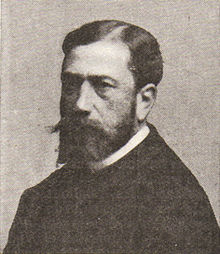Paul Vayson
Paul Vayson (born December 4, 1841 in Gordes ( Département Vaucluse ), † December 14, 1911 in Paris ) was a French painter of impressionism and realism .
Life
He first attended the Lyceum in Avignon and then came to Paris to study law. But his inclination to art was stronger: in 1864 he entered the studio of the Swiss painter Charles Gleyre . Even Jules Laurens received him in his studio. Vayson met Jean-Baptiste Camille Corot and Gustave Courbet personally. Extensive trips that brought him to Italy, Holland and Spain were not without echo in his painterly work. He brought home mainly Spanish motifs. From 1896 (after the death of his brother in this position) until the end of his life he was mayor of Murs (Vaucluse) , where his family owned the local castle.
Artistic creation

Vayson was close to impressionism. The realistic tendency of Gustave Courbet's painting attracted him more than the romantic tendencies of his teacher Gleyre, who preferred religious, mythological and historical subjects. He preferred plein-air painting. His favorite subjects were rural scenes from Provence. According to the Allgemeine Künstler-Lexikon (published by Hans Wolfgang Singer , 4th vol., 1921, p. 487) he was "a respected animal painter, especially his cattle and hammers were well received".
Awards and honors
- 1875 Médaille de 3eme Classe, Salon Paris for: Une gardeuse de moutons dans une vallée
- 1879 Médaille de 2eme Classe, Salon Paris for: Les moutons
- 1886 Legion of Honor
- 1896–1911 Mayor of Murs (Vaucluse)
- Member of the jury of the Paris Salon des beaux-arts
- September 18, 1913 Monument in honor of Paul Vayson in the Rocher des Doms Park in Avignon, created by Félix Charpentier, opened in the presence of the Nobel Prize winner Frédéric Mistral
Works in public collections and museums
- Musée du Louvre : " Jeune gardeuse de moutons ", drawing
- Grobet-Labadié Museum in Marseille , Bouches-du-Rhône : Drawings: " Vaches en Sologne "; " Moutons au pâturage " (n ° inv: 4265); " Moutons au pâturage " (n ° inv: 4153)
- Musée des beaux-arts de Marseille : " Rentrée des moutons sous l'orage "; " Les Taureaux de Camargue "; " Les moutons dans la combe de Bezaure (Provence) "; " La bergère endormie "
- Musée Calvet , Avignon: " L'enfant prodigue gardant les porcs "
- Musée des Beaux-Arts de Nantes , Loire-Atlantique : " Le Berger et la Mer "
- Musée de Grenoble , Isère : " Etude pour la tricoteuse "; " Gardeuse de moutons "
- Musée des beaux-arts de Bordeaux , Gironde : " L'Enfant prodigue "
- Museum Villeneuve-lès-Avignon , Gard : " Pensées "
- Orléans Museum , Loiret : " Chasseurs de la Camargue "
- Charmes Museum , Vosges : " Bergère dans les Landes "
- Gare de Lyon , Paris, Salle Dorée of the restaurant Le Train bleu : " Hyères "
literature
- Jules Belleudy: Paul Vayson, l'homme, l'artiste. Paris, Blaizot 1912.
- Hermann Alexander Müller: Biographical Artist Lexicon of the Present. The most famous contemporaries in the entire field of the visual arts of all countries with details of their works. Publishing house of the Bibliographisches Institut, Leipzig 1882.
- Hans Wolfgang Singer (Hrsg.): General artist lexicon. Volume 4 and 6, Rütten & Loening, Frankfurt am Main 1921 and 1922 respectively.
- Rose-Léone Moulierac-Lamoureux: Paul Vayson, peintre du Comtat, 1841-1911. Dissertation with Jacques Bousquet. Université Paul Valéry, Montpellier 1983 (BU Montpellier, sect.Lettres, réf.TL MON 1983 63 bis1 et 63 bis2)
- Le Train Bleu. Press Lois Unis Service, Paris 1990, ISBN 2-908557-01-0 .
- Dictionnaire Bénézit . Basic
- Mario Proth: Voyages aux pays des peintres, Salon de 1875. Large Print, Bibliobazaar LLLC, 2008 (3 paintings, pp. 43, 44)
- Le Progrès Illustré. n ° 116 du 5 mars 1893, p. 2, review of the Salon Lyonnais
- Dictionnaire des peintres de Montmartre.
- Album Disdéri. numéro 16, p. 42, peintres et sculpteurs RMN, photo: René- Gabriel Ojéda Paris Musée d'Orsay
- D. Alaux: Catalog des tableaux du Musée de peinture de Bordeaux. Bordeaux 1910
- D. Dussol: Le Salon des Amis des Arts de Bordeaux (1851-1939). Dissertation. Université Michel Montaigne, Bordeaux 1994, pp. 866, 866 + 7 and 277.
- Saint Do V: L'Enfant Prodigue fait des petits. In: Sud-Ouest. Oct 9, 1997.
- The New-York Times. 14 Dec 1911, p. 13.
- Inventaire general des richesses d'art de la France. Tome VI, Paris 1892 / -Cat, p. 47.
- Jules Bernard : Catalogs des tableaux, statues, bas reliefs et objets d'art exposés dans les galeries du musée de peinture et de sculpture de Grenoble. Grenoble 1901 / Catn ° 357, p. 122.
- Jules Bernard : Catalog .... Grenoble Impr et lithographie Louis Ginier 1911 / Cat.n ° 438, p. 126.
Web links
- Jules Belleudy: Paul Vayson, l'homme, l'artiste Paris, Blaizot 1912 (PDF in the Bibliothèque numérique de l'école nationale des chartes )
Individual evidence
- ↑ La Gazette de l'Inguimbertine. Petit journal de la bibliothèque, des archives et des musées de la ville de Carpentras , Janvier 2012, no. 55
| personal data | |
|---|---|
| SURNAME | Vayson, Paul |
| BRIEF DESCRIPTION | French painter and draftsman |
| DATE OF BIRTH | December 4, 1841 |
| PLACE OF BIRTH | Gordes |
| DATE OF DEATH | December 14, 1911 |
| Place of death | Paris |

